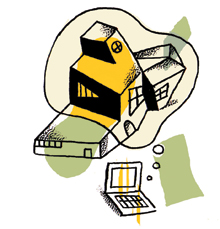Build from Scratch
From time to time, harrumphing old-timers, tabloid columnists, and talk radio hosts get in a twist about buildings that twist instead of going straight up and down. They rail against structures that defy conceptions of rationality they take to be self-evident (see “The Building, Digitally Remastered”).

But these conceptions are framed by unexamined assumptions about technological possibilities and social priorities. They are framed by ideology.
If, for example, your primary goal is to minimize the construction cost of a large project, it is rational to try to minimize the surface-to-volume ratio and thus the amount of enclosing material. This strategy produces fat, dumpy, boxy buildings that leave most of their inhabitants deep in interior spaces far from windows.
But people like natural light, air, and views of the outside. So if you care more about that, it is rational to maximize surface-to-volume ratio, producing a highly reticulated building like MIT’s Stata Center. This democratic strategy puts many people on the exterior and gives a lot of them corner offices.
If you are an unregenerate Taylorist in your conception of productive work, it is rational to maximize the amount of office or laboratory space on a floor while shrinking circulation and public areas. This is what architects know as maximizing the net-to-gross ratio. It produces grim, cramped interiors like those of the older laboratories at MIT, with long, straight central corridors.
But if you believe that innovation depends upon serendipitous encounters, intellectual cross-connections, and informal social networks within organizations, it is rational to provide plenty of space to support such social dynamics. You will invest more heavily in public spaces–generous interior streets and piazzas–instead of mere circulation channels.
If you think construction should be about achieving economies of scale through standardization and mass production, it is rational to design buildings consisting of repeating floors composed of repeating rooms made from repeating components on repeating grids.
But if you value responsiveness to varied local needs and conditions, celebration of diversity and complexity, and the joy of the unexpected, you might want something more from architecture. And if you understand the possibilities of combining computer-aided design with digitally controlled fabrication and assembly, you will know that complex, nonrepetitive buildings like the “Gherkin” in London or the Turning Torso in Malmö, Sweden, can now be created without excessively high costs.
Technology does not determine architectural form; it serves as an enabler. New tools–most recently digital design and construction technologies–open up new spatial and material possibilities for exploration. Daring and imaginative architects have seized the opportunity.
Keep Reading
Most Popular
Large language models can do jaw-dropping things. But nobody knows exactly why.
And that's a problem. Figuring it out is one of the biggest scientific puzzles of our time and a crucial step towards controlling more powerful future models.
How scientists traced a mysterious covid case back to six toilets
When wastewater surveillance turns into a hunt for a single infected individual, the ethics get tricky.
The problem with plug-in hybrids? Their drivers.
Plug-in hybrids are often sold as a transition to EVs, but new data from Europe shows we’re still underestimating the emissions they produce.
Stay connected
Get the latest updates from
MIT Technology Review
Discover special offers, top stories, upcoming events, and more.